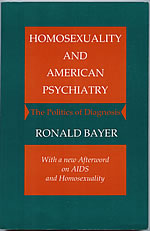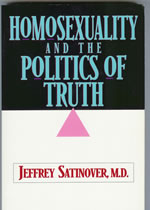In 1973, the American Psychiatric Association (APA) removed homosexuality as a mental disorder from the APA's Diagnostic and Statistical Manual Of Mental Disorders (DSM-II).
This decision was a significant victory for homosexual activists, and they have continued to claim that the APA based their decision on new scientific discoveries that proved that homosexual behavior is normal and should be affirmed in our culture.
This is false and part of numerous homosexual urban legends that have infiltrated every aspect of our culture. The removal of homosexuality as a mental disorder has given homosexual activists credibility in the culture, and they have demanded that their sexual behavior be affirmed in society.
What Really Happened?
Numerous psychiatrists over the past decades have described what forces were really at work both inside and outside of the American Psychiatric Association-and what led to the removal of homosexuality as a mental disorder.
 Dr. Ronald Bayer explains how homosexual activists captured the APA for political gain. |
Dr. Ronald Bayer, a pro-homosexual psychiatrist has described what actually occurred in his book, Homosexuality and American Psychiatry: The Politics of Diagnosis. (1981)
In Chapter 4, "Diagnostic Politics: Homosexuality and the American Psychiatric Association," Dr. Bayer says that the first attack by homosexual activists against the APA began in 1970 when this organization held its convention in San Francisco. Homosexual activists decided to disrupt the conference by interrupting speakers and shouting down and ridiculing psychiatrists who viewed homosexuality as a mental disorder. In 1971, homosexual activist Frank Kameny worked with the Gay Liberation Front collective to demonstrate against the APA's convention. At the 1971 conference, Kameny grabbed the microphone and yelled, "Psychiatry is the enemy incarnate. Psychiatry has waged a relentless war of extermination against us. You may take this as a declaration of war against you."
Homosexuals forged APA credentials and gained access to exhibit areas in the conference. They threatened anyone who claimed that homosexuals needed to be cured.
Kameny had found an ally inside of the APA named Kent Robinson who helped the homosexual activist present his demand that homosexuality be removed from the DSM. At the 1972 convention, homosexual activists were permitted to set up a display booth, entitled "Gay, Proud and Healthy."
Kameny was then permitted to be part of a panel of psychiatrists who were to discuss homosexuality. The effort to remove homosexuality as a mental disorder from the DSM was the result of power politics, threats, and intimidation, not scientific discoveries.
Prior to the APA's 1973 convention, several psychiatrists attempted to organize opposition to the efforts of homosexuals to remove homosexual behavior from the DSM. Organizing this effort were Drs. Irving Bieber and Charles Socarides who formed the Ad Hoc Committee Against the Deletion of Homosexuality from DSM-II.
The DSM-II listed homosexuality as an abnormal behavior under section "302. Sexual Deviations." It was the first deviation listed.
After much political pressure, a committee of the APA met behind closed doors in 1973 and voted to remove homosexuality as a mental disorder from the DSM-II. Opponents of this effort were given 15 minutes to protest this change, according to Dr. Jeffrey Satinover, in Homosexuality and the Politics of Truth. Satinover writes that after this vote was taken, the decision was to be voted on by the entire APA membership. The National Gay Task Force purchased the APA's mailing list and sent out a letter to the APA members urging them to vote to remove homosexuality as a disorder. No APA member was informed that the mailing had been funded by this homosexual activist group.
According to Satinover, "How much the 1973 APA decision was motivated by politics is only becoming clear even now. While attending a conference in England in 1994, I met a man who told me an account that he had told no one else. He had been in the gay life for years but had left the lifestyle. He recounted how after the 1973 APA decision, he and his lover, along with a certain very highly placed officer of the APA Board of Trustees and his lover, all sat around the officer's apartment celebrating their victory. For among the gay activists placed high in the APA who maneuvered to ensure a victory was this man-suborning from the top what was presented to both the membership and the public as a disinterested search for truth."
Dr. Socarides Speaks Out
 Dr. Satinover shows how APA's policies were influcenced by closeted homosexual APA leaders. |
Dr. Charles Socarides has set the record straight on how homosexuals inside and outside of the APA forced this organization to remove homosexuality as a mental disorder. This was done without any valid scientific evidence to prove that homosexuality is not a disordered behavior.
Dr. Socarides, writing in Sexual Politics and Scientific Logic: The Issue of Homosexuality writes: "To declare a condition a 'non-condition,' a group of practitioners had removed it from our list of serious psychosexual disorders. The action was all the more remarkable when one considers that it involved an out-of-hand and peremptory disregard and dismissal not only of hundreds of psychiatric and psychoanalytic research papers and reports, but also a number of other serious studies by groups of psychiatrists, psychologists, and educators over the past seventy years…"
Socarides continued: "For the next 18 years, the APA decision served as a Trojan horse, opening the gates to widespread psychological and social change in sexual customs and mores. The decision was to be used on numerous occasions for numerous purposes with the goal of normalizing homosexuality and elevating it to an esteemed status.
"To some American psychiatrists, this action remains a chilling reminder that if scientific principles are not fought for, they can be lost-a disillusioning warning that unless we make no exceptions to science, we are subject to the snares of political factionalism and the propagation of untruths to an unsuspecting and uninformed public, to the rest of the medical profession, and to the behavioral sciences." Dr. Socarides' report is available from the National Association for Research and Therapy of Homosexuality: www.narth.com.
THE IMPORTANCE OF THE DSM
The DSM (Diagnostic and Statistical Manual of Mental Disorders) is the most widely used diagnostic reference book utilized by mental health professionals in the United States.
It's a manual by which all diagnostic codes are derived for diagnosis and treatment - every single physician (an estimated 850,000*) in the United States refers to this book in order to code for a diagnosis. In plain English, what does this mean? It means that for over 30 years physicians have been prevented from properly diagnosing homosexuality as an aberrant behavior and thus, cannot, recommend a course of treatment for these individuals.
Prior to that time, homosexuality had been treated as a mental disorder under section "302. Sexual Deviations" in the DSM-II. Section 302 said, in part: "This category is for individuals whose sexual interests are directed primarily toward objects other than people of the opposite sex, toward sexual acts … performed under bizarre circumstances. … Even though many find their practices distasteful, they remain unable to substitute normal sexual behavior for them." Homosexuality was listed as the first sexual deviation under 302. Once that diagnostic code for homosexuality was removed, physicians, including psychiatrists, have been prevented from diagnosing homosexuality as a mental disorder for more than three decades.
*American Medical Association statistic, 2002.
TO DOWNLOAD THIS REPORT IN PDF FORMAT FOR REDISTRIBUTION, CLICK HERE
